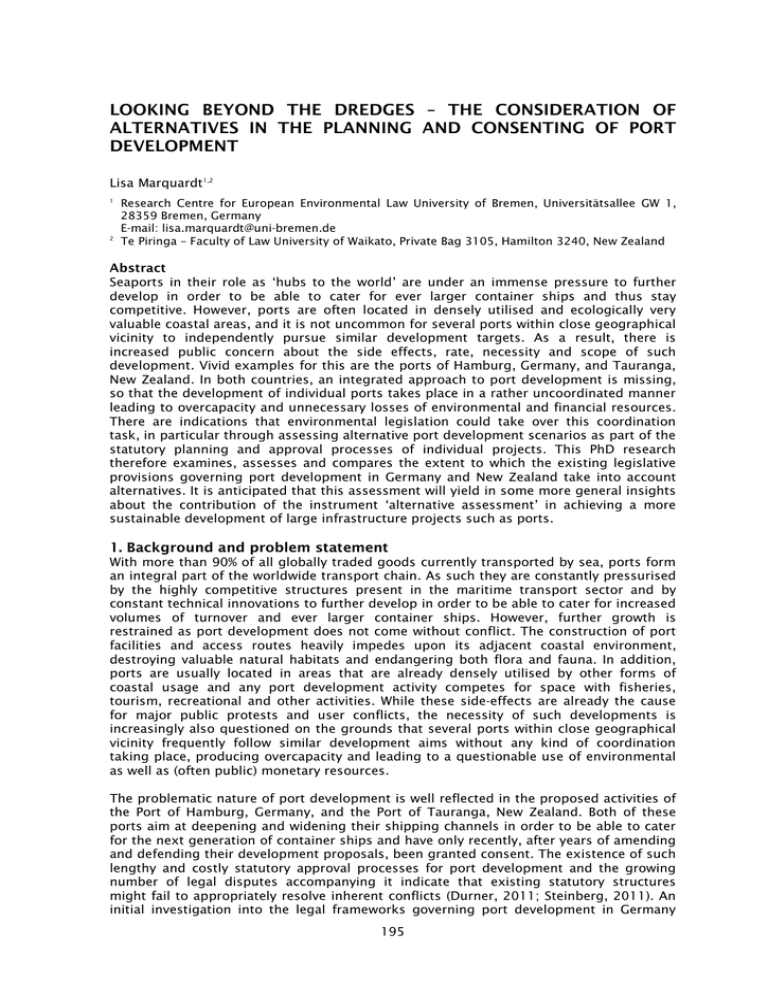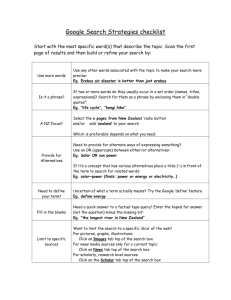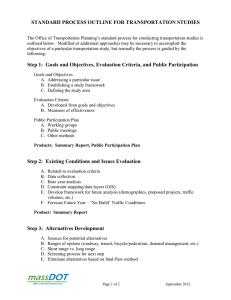LOOKING BEYOND THE DREDGES – THE CONSIDERATION OF
advertisement

LOOKING BEYOND THE DREDGES – THE CONSIDERATION OF ALTERNATIVES IN THE PLANNING AND CONSENTING OF PORT DEVELOPMENT Lisa Marquardt1,2 1 2 Research Centre for European Environmental Law University of Bremen, Universitätsallee GW 1, 28359 Bremen, Germany E-mail: lisa.marquardt@uni-bremen.de Te Piringa – Faculty of Law University of Waikato, Private Bag 3105, Hamilton 3240, New Zealand Abstract Seaports in their role as ‘hubs to the world’ are under an immense pressure to further develop in order to be able to cater for ever larger container ships and thus stay competitive. However, ports are often located in densely utilised and ecologically very valuable coastal areas, and it is not uncommon for several ports within close geographical vicinity to independently pursue similar development targets. As a result, there is increased public concern about the side effects, rate, necessity and scope of such development. Vivid examples for this are the ports of Hamburg, Germany, and Tauranga, New Zealand. In both countries, an integrated approach to port development is missing, so that the development of individual ports takes place in a rather uncoordinated manner leading to overcapacity and unnecessary losses of environmental and financial resources. There are indications that environmental legislation could take over this coordination task, in particular through assessing alternative port development scenarios as part of the statutory planning and approval processes of individual projects. This PhD research therefore examines, assesses and compares the extent to which the existing legislative provisions governing port development in Germany and New Zealand take into account alternatives. It is anticipated that this assessment will yield in some more general insights about the contribution of the instrument ‘alternative assessment’ in achieving a more sustainable development of large infrastructure projects such as ports. 1. Background and problem statement With more than 90% of all globally traded goods currently transported by sea, ports form an integral part of the worldwide transport chain. As such they are constantly pressurised by the highly competitive structures present in the maritime transport sector and by constant technical innovations to further develop in order to be able to cater for increased volumes of turnover and ever larger container ships. However, further growth is restrained as port development does not come without conflict. The construction of port facilities and access routes heavily impedes upon its adjacent coastal environment, destroying valuable natural habitats and endangering both flora and fauna. In addition, ports are usually located in areas that are already densely utilised by other forms of coastal usage and any port development activity competes for space with fisheries, tourism, recreational and other activities. While these side-effects are already the cause for major public protests and user conflicts, the necessity of such developments is increasingly also questioned on the grounds that several ports within close geographical vicinity frequently follow similar development aims without any kind of coordination taking place, producing overcapacity and leading to a questionable use of environmental as well as (often public) monetary resources. The problematic nature of port development is well reflected in the proposed activities of the Port of Hamburg, Germany, and the Port of Tauranga, New Zealand. Both of these ports aim at deepening and widening their shipping channels in order to be able to cater for the next generation of container ships and have only recently, after years of amending and defending their development proposals, been granted consent. The existence of such lengthy and costly statutory approval processes for port development and the growing number of legal disputes accompanying it indicate that existing statutory structures might fail to appropriately resolve inherent conflicts (Durner, 2011; Steinberg, 2011). An initial investigation into the legal frameworks governing port development in Germany 195 and New Zealand has exposed the fact that neither of the two countries has legal provisions in place that explicitly coordinate the development of its ports from a more strategic point of view. This explains why the expansion aims of both the ports of Hamburg and Tauranga were approved despite similar developments currently undertaken at other nearby container ports (JadeWeserPort/ Port of Auckland), and additionally stresses the need to investigate current statutory governance structures. There are indications that the existing environmental legislation, in absence of strategic guidance for port development, could at least to a certain extent take over the important coordination task through the obligation to assess alternatives to the individual project as part of the planning and project approval process, and thus prevent user conflicts and the wasteful use of environmental and financial resources (Winter, 2012). 2. Literature discussion The idea of assessing alternatives in order to make good choices is not a new approach. Conceptually rooted in rational decision-making theory, the importance of considering several options has also been recognised as an essential part of precautionary administrative and environmental decision-making (Winter, 1997; O’Brien, 1999; Steinemann, 2001). Internationally praised as the “heart” of environmental impact assessment (Holder, 2004), the tool has also gained considerable momentum in German discussions regarding the planning and approval of major industrial and infrastructure developments (Friedrichsen, 2005; Durner, 2011; Wulfhorst, 2011; Winter, 2012). While in New Zealand, the issue of alternatives has not been explicitly discussed in detail, it has gained some attention within the assessment of the country’s framework for strategic and project-related environmental assessment (McGimpsey & McMullan, n.d.; Memon, 2005; Young Cooper, 2005). Alternative assessment has the purpose to examine whether alternative options to that proposed exist that, while still achieving the same objective, do so with less negative impacts. The range of alternatives that are commonly subject to such an assessment are different types or scopes of development (conceptual alternatives), undertaking the activity at a different location (spatial alternatives) or not undertaking the project at all (zero alternative). Supporters praise alternative assessment as a smart instrument that, instead of focusing on the problem, stimulates the search for an optimal solution and thus prevents a premature focus on one option (Winter, 2012). Extensive public participation throughout the assessment process furthermore helps to decrease user conflicts and reduce risks, and may also function as a motor for innovation (Tickner & Geiser, 2004). Critical voices argue that extended requirements for alternative assessment would lead to more costly and lengthy approval processes, thus overburdening both project applicants and approval authorities. 3. Research method and rationale It is the aim of this PhD research project to assess the potential of the tool ‘alternative assessment’ to improve public decision-making regarding ambitious infrastructure developments in absence of clear strategic guidance. Taking a comparative approach, the multi-tiered planning and approval processes governing port development in Germany and New Zealand are analysed with regards to obligations to consider alternatives, followed by a comparison of the findings and their review against the prevailing lines of argumentation in academic writing. 4. Preliminary Findings Both Germany and New Zealand have multi-tiered planning systems in place that, broadly speaking, consist of a strategic/ comprehensive level that aims at coordinating all kinds of activities and protection requirements, and the approval level of individual (port) projects. While the actual statutory requirements for alternatives differ, authorities in both countries enjoy a certain discretionary freedom when deciding about whether and which alternatives to consider. In Germany, a number of statutory provisions require alternative assessment during the planning and approval of port developments. During the development of infrastructure and spatial plans authorities are obliged to consider alternatives that are “reasonable at 196 the respective state of planning” (§§ 14g(1), 16(4) UVPG), while “reasonable alternative locations” need to be considered during regional planning and route determination procedures (§15(1) ROG, §16(1) UVPG). In addition, the statutory requirement to weigh affected matters among and against each other during decision-making about the final approval requires the authority to consider “reasonable alternatives”, i.e., according to the Federal Administrative Court, those “that present or impose themselves on the merits of the case” (BVerwGE 69, 256). Further substantive standards for alternative assessment are set in sectoral law, such as the needs to consider “other possible solutions” proposed by the proponent as part of environmental impact assessment (§36(4) no. 3 UVPG) and “reasonable alternatives” to the project as imposed by conservation law (§31(2) no. 2 BNatSchG). In comparison, requirements for alternative assessment under New Zealand law are rather sparsely sown. Thus, there is no explicit requirement for alternatives to be taken into account when developing transport policies, and while authorities developing environmental policies and management plans are obliged to assess whether proposed management measures are the “most appropriate to achieve objectives” (RMA s 32), this does not necessarily translate into a requirement to assess different development scenarios. On the approval level, New Zealand consent authorities need to consider alternatives within their jurisdiction that are “relevant and reasonably necessary to determine the obligation” (RMA ss 88, 92 & Sch 4). However, the Environment Court in Meridian Energy Ltd v Central Otago District Council has clearly stated that the decision should be made on the merits of the case and that “the consideration of alternative sites should not be pushed too far.” While the present research is still in progress, the necessity and justification for an expansion of the requirements regarding alternative assessment during the planning and approval of major infrastructure projects in both Germany and New Zealand has already become clear. Matters that need to be paid particular attention to in Germany are the limitedness of the range of alternatives that need to be considered and the general dominance given to the proponent during alternative assessment that is criticised in the literature (Durner, 2011). New Zealand’s environmental management regime, too, can be expected to benefit from strengthened statutory requirements for alternative assessment in particular as part of strategic environmental assessment of transport plans but also on the approval level, as existing statutory guidance is vague and leads to major implementation problems as well as unsustainable practices (McGimpsey & McMullan, n.d.; Memon, 2005; Ward et al, 2005). It can be expected that the in-depth comparison of the two approaches to be undertaken in the months to come will yield further valuable insights. 5. Conclusion The research undertaken so far highlights the general potential of assessing alternatives during statutory planning and approval processes governing ambitious infrastructure projects such as ports. In particular in absence of higher level strategic guidance, the tool can provide an important contribution to a more sustainable development of ports in coordinating individual projects and thus decreasing the number of conflicts and wasteful use of environmental as well as financial resources. This, however, necessitates a clear and specific implementation of the requirement to assess alternatives as early as possible in the statutory planning process and under wide participation of all affected right from the start. In the final approval process, alternative assessment might work as some kind of ‘security device’ to prevent overly destructive projects from being approved. However, it cannot be considered as the optimal location for the application of this tool as there are limits to the range of alternatives that can or should be considered at this stage without running the risk of ‘overburdening’ the whole final approval. 197 References Durner W. 2011. Möglichkeiten der Verbesserung förmlicher Verwaltungsverfahren am Beispiel der Planfeststellung. Zeitschrift für Umweltrecht 7-8:345-362. Friedrichsen L. 2005. Umweltbelastende Vorhaben und Alternativen in der Planfeststellung. Frankfurt/Main: Peter Lang. Holder J. 2004. Environmental Assessment. The Regulation of Decision Making. Oxford: Oxford University Press. McGimpsey P. and McMullan, M. n.d. Strategic Environmental Assessment and Regional Transport Planning : Opportunities in New Zealand. Memon A. 2005. SEA of Plan Objectives and Policies to Promote Sustainability in New Zealand. In : Schmidt M., João E. and Albrecht E. (eds). Implementing Strategic Environmental Assessment. Berlin/ Heidelberg: Springer. O’Brien M. 1999. Alternatives assessment: part of operationalizing and institutionalizing the precautionary principle. In: Reffensperger C., Tickner J. and Jackson W. (eds). Protecting Public Health and the Environment: Implementing the Precautionalry Principle. Covelo, CA: Island Press. Steinberg R. 2011. Die Bewältigung von Infrastrukturvorhaben durch Verwaltungsverfahren – eine Bilanz. Zeitschrift für Umweltrecht 7-8:340-350. Steinemann A. 2001. Improving Alternatives for environmental impact assessment. Environmental Impact Assessment Review 21:3-21. Tickner J. and Geiser K. 2004. The precautionary principle stimulus for solutions- and alternativesbased environmental policy. Environmental Impact Assessment Review 24: 801-824. Ward M., Wilson, J. and Sadler B. 2005. Application of Strategic Environmental Assessment to Regional Land Transport Strategies. Land Transport New Zealand Research Report 275. Wellington: Land Transport New Zealand. Winter G. 1997. Alternativen in der administrativen Entscheidungsbildung: Zugleich ein Beitrag zu einer Grundpflicht ökologischer Verhältnismäßigkeit. Düsseldorf: Werner. Winter G. 2012. Balancing Environmental Risks and Socio-Economic Benefits of Alternatives: A General Principle and its Application in Natura 2000. In: Backer, O K, Fauchald, I L, Voigt, C (eds): Pro Natura - Festskrift til Hans Christian Bugge. Oslo: Universitetsforlaget. – 4 Wulfhorst R. 2011. Neue Zeitschrift für Verwaltungsrecht 18:1099-1103. Die Untersuchung von Alternativen im Rahmen der Strategischen Umweltprüfung. Young Cooper A. 2005. Streamlining RMA Approvals for Land Transport Projects. A study of delays in major roading projects. Wellington: Ministry for the Environment. 198




